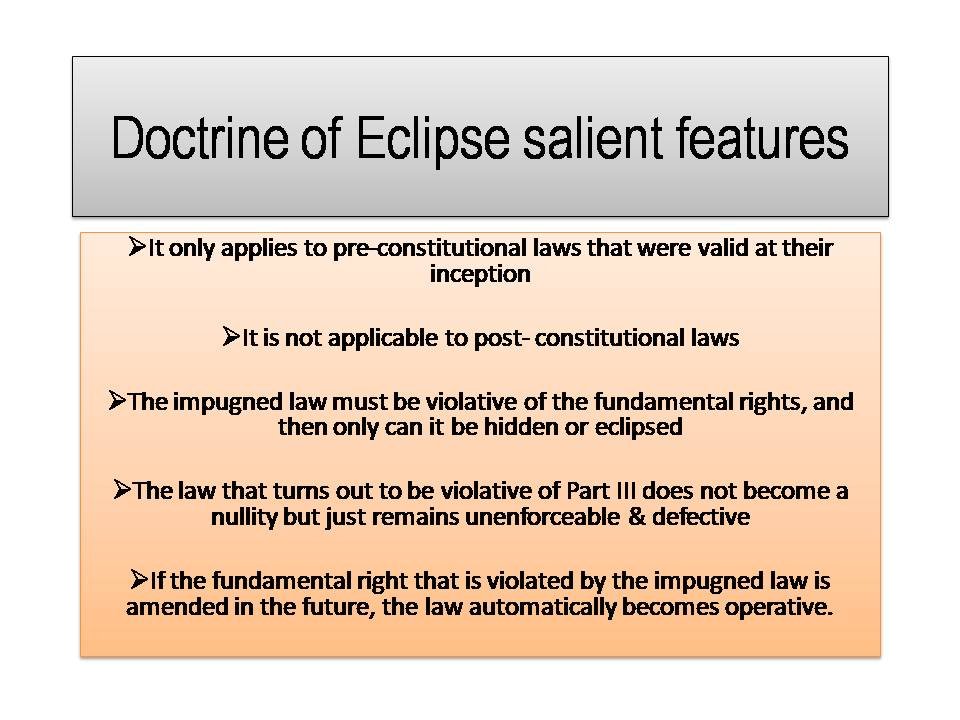The doctrine of eclipse and severability: The Eclipse (hidden) doctrine is based on the principle that a law that violates a fundamental right must nullify the beginning, but only to become inapplicable. Such laws have not been completely removed from statutes; and exist for all past transactions, in this regard, it should be clarified that the doctrine of the eclipse applies in the case of pre-constitutional law and not post-constitutional law.
The doctrine of eclipse
The word “void” used in clause (1) of Article 13 (about the law existing at the time of the constitution) is generally taken to mean only un-enforceable and not a total nullity but the same word occurring in Article 13 (2) (about future laws) has been taken to mean that the law concerned is void-ab-initio and a total nullity.

It is so because in the case of existing law if no amendment of the relevant provision of the fundamental right affected by the impugned law, the constitutional bar is removed and the laws become void on the ground of inconsistency with a fundamental right at the commencement of the constitution will again become valid. It is called the Doctrine of Eclipse. The doctrine of eclipse way that a legitimate pre-constitution regulation that has become void both in complete or in component turns into inoperative as long as its inconsistency with Part III of the constitution exists.
Such a regulation. however, does disappear from the statute book because it existed earlier than the date of the charter is recognized. But if in disobedience of the mandate this sort of regulation, which is inconsistent with the Fundamental Rights or the charter, is exceeded after the constitution, it’s far a useless or stillborn regulation and is to be overlooked for all purposes.

Origin of eclipse doctrine
The Eclipse Doctrine was reviewed by the Supreme Court in Bhikhaji Narain v. M.P.A.I State. R. 1955 S.C. 78, and it was found that the existing (pre-constitutional) law was not dead yet and could be reinstated by any subsequent constitutional amendments.
But no right and obligations can be based on that from the date of the constitution till the date of its amendment unless the amendment is expressly made retrospective. Case Deep Chand V. State of U.P (A.I.R-1959) The Supreme Court held that the doctrine of eclipse does not apply to post-constitution laws.
CASE LAWS
The Doctrine of Eclipse has developed through various Supreme Court rulings since the adoption of the Constitution.
Keshav Madhav Menon v. State of Bombay
In the case of Keshav Madhav Menon v. State of Bombay, the petitioner faced charges under the Indian Press (Emergency Powers) Act of 1931 for publishing a pamphlet without permission. The Constitution’s enactment raised questions about the prospective and retrospective aspects of Article 13(1) and the term “void.” The Court determined that the Act violated Article 19(1)(a) and deemed it void only to the extent of the violation, clarifying that “void” in Article 13 does not necessitate the repeal of entire statutes.
FN Balsara case
In the FN Balsara case, the Court invalidated Section 13(b) of the Bombay Prohibition Act of 1949 for contravening Article 19(1)(f). Once more, the Court specified that only the offending portion of a statute, not the entire statute, is rendered inoperative.
Bhikaji Narain Dhakras v. State of Madhya Pradesh
The genesis of the Doctrine of Eclipse is often attributed to the Bhikaji Narain Dhakras v. State of Madhya Pradesh case. Here, the C.P. and Berar Motor Vehicles Amendment Act of 1947, a pre-constitutional law, was challenged for breaching Article 19(1)(g). Applying the Doctrine of Eclipse, the Court rendered the Act’s provisions inoperative.
However, in 1951, the 1st Constitutional Amendment Act amended Article 19(1)(g), removing the eclipse and making the law enforceable. The Court stated that the amendment “removed the shadow,” making the Act free from any flaws.
Doctrine of Severability
The doctrine of severability (to separate) states that if a ruling cannot be preserved by interpretation if it is consistent with its constitutionality, it can be seen if it can be partially preserved.
If a law, whether it is a law that came into force from the moment the Constitution came into force or a law that came into force after that, is incompatible or violates fundamental rights, this law will be declared invalid by the Court.
The doctrine of severability/separation applies only if the legal part can be separated from the unconstitutional part of the provision; if it cannot be divided, the whole provision should be overturned as unconstitutional.
The issue of severability does not depend on the interpretation of the Constitution but on the formulation of the law of the dispute. The history of law is acceptable for determining legislative intent when it comes to separation, but the statements of objects and causes are not acceptable. to determine divisibility.
Thus, the doctrine of severability or separation implies that not all actions should be declared invalid, but only those provisions that violate fundamental rights, provided, of course, that the part that violates fundamental rights will be severed. that does not violate them, and if they are inseparable, the whole action is invalid.
Important case laws of this Doctrine
Many important cases have discussed the doctrine of severability and eclipse. Some of them are:-
In the case of Kihoto Hollohan vs Zachillhu and others (AIR-1992)
It is argued that the doctrine of separability holds that if a statute can be explained so that its validity can be maintained against a constitutional attack, it needs to be explained when part of the statute is in effect and part is invalid. , the real part must be separated from the invalid part.
In the case of D.S Nakara & others vs U.O.I(Union of India), (AIR -1983)
The Court stated that as long as the classification is found to be inadmissible and the remedy can be maintained by removing the unconstitutional part of the classification or restrictive words, this could be an extension of the classification. the court can override a limited number of words in an enactment. This is what is called reading down the measures.
In the case of A.K.Gopalan vs State of Madras,(AIR-1950)
The principles of divisibility were also discussed. The court noted that we must see if the omission of the disputed part of the act does not change the nature of the structure or object of the law. “
That’s all for the topic of The doctrine of Eclipse and Severability if you wanna know more related to this topic or have any specific questions, please comment below, thanks.

























